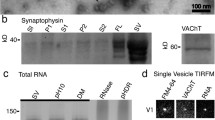Abstract
Synaptic vesicles play a central role in neurotransmission as the transmitter storing and releasing organelles of the nerve terminal.In recent years progress has been made in functional identification of vesicle specific components.Most of this work has been done on synaptic vesicles isolated from electric organs of Torpedo marmorata (Stadler et al.,1985), a purely cholinergic model system.More recently a few proteins specific to brain synaptic vesicles have been isolated and characterized as well.Integration of the findings leads to a first model of the vesicle structure including aspects of uptake and storage of the solutes within these organelles. The major core protein of cholinergic vesicles, a heparan - sulfate proteoglycan (Stadler and Dowe,1982),is a secretory protein.This protein can be labelled in vivo with S-sulfate and this labelling technique enabled us to study the heterogeneity of these vesicles and their life cycle in the nerve terminal in more detail than previously.These findings provide new aspects towards understanding quantal release and synapse formation in this system.Furthermore we present evidence that mammalian brain synaptic vesicles may contain a proteoglycan-like component suggesting that it is a secretory protein as well.
Access this chapter
Tax calculation will be finalised at checkout
Purchases are for personal use only
Preview
Unable to display preview. Download preview PDF.
Similar content being viewed by others
References
Anderson, D.C.,King, S.C. and Parsons, S.M. (1982). Proton gradient linkage to active uptake of 3h]acetylcholine by Torpedo electric organ synaptic vesicles. Biochemistry 21, 3037–3043
Dunant, Y. and Muller, D. (1986). Quantal release of acetylcholine evoked by focal depolarization at the Torpedo nerve-electroplaque junction. J. Physiol. 379, 461–478
Fallon, J.R., Nitkin, R.M., Reist, N.E., Wallace, B.G. and McMahan, U.J. (1985). Acetylcholine receptor-aggregating factor is similar to molecules concentrated at neuro - muscular junctions. Nature 315, 571–574
Fuldner, H.H. and Stadler, H. (1982). 31P-NMR analysis of synaptic vesicles. Status of ATP and internal pH. Eur. J. Biochem. 121 519–524
Harlos,P., Lee, D.A. and Stadler, H. (1984). Characterization of a Mg++-ATPase and a proton pump in cholinergic synaptic vesicles from the electric organ of Torpedo marmorata.
Israel, M.,Manaranche, R./ Marsal, J., Meunier, F.M., Morel, N., Frachon, P. and Lesbats, B. (1980). ATP-dependent calcium uptake by cholinergic synaptic vesicles isolated from Torpedo electric organ. J. Membrane Biol. 54, 115- 126
Kiene, M.L. and Stadler, H. (1987). Synaptic vesicles in electromotoneurones.I. Axonal transport, site of transmitter uptake and processing of a core proteoglycan during maturation. EMBO J. 6, 2209–2215
Lee, D.A. and Witzemann, V. (1983). Photoaffinity labeling of a synaptic vesicle specific nucleotide transport system from Torpedo marmorata. Biochemistry 22, 6123–6130
Stadler, H. and Fuldner, H.H. (1980). Proton NMR detection of acetylcholine status in synaptic vesicles. Nature 286, 293–294
Stadler, H. and Dowe, G.H.C. (1982). Identification of heparansulfate proteoglycan in the core of synaptic vesicles of Torpedo marmorata. EMBO J. 1, 1381–1384
Stadler, H. and Fenwick, E.M. (1983). Cholinergic synaptic vesicles from Torpedo marmorata contain an atractyloside-binding protein related to the mitochondrial ADP/ATP carrier. Eur. J. Biochem. 136, 377–382
Stadler, H., Kiene, M.L., Harlos, P. and Welscher, U. (1985) Structure and function of cholinergic synaptic vesicles. In Hamprecht, B. and Neuhoff, V. (eds.),Neurobiochemistry Springer Verlag Berlin, p. 55–65
Stadler, H. and Kiene, M.L. (1987). Synaptic vesicles in electromotoneurones. il. Heterogeneity of populations is expressed in uptake properties; exocytosis and insertion of a core proteoglycan into the extracellular matrix. Embo J. 6, 2217–2221
Zimmermann, H. and Whittaker, V.P. (1977). Morphological and biochemical heterogeneity of cholinergic synaptic vesicles. Nature 267, 633–635
Author information
Authors and Affiliations
Editor information
Editors and Affiliations
Rights and permissions
Copyright information
© 1988 Springer-Verlag Berlin Heidelberg
About this paper
Cite this paper
Stadler, H., Borroni, E., Ploghöft, M., Kiene, ML. (1988). Structure and Function of Synaptic Vesicles:New Aspects. In: Zimmermann, H. (eds) Cellular and Molecular Basis of Synaptic Transmission. NATO ASI Series, vol 21. Springer, Berlin, Heidelberg. https://doi.org/10.1007/978-3-642-73172-3_20
Download citation
DOI: https://doi.org/10.1007/978-3-642-73172-3_20
Publisher Name: Springer, Berlin, Heidelberg
Print ISBN: 978-3-642-73174-7
Online ISBN: 978-3-642-73172-3
eBook Packages: Springer Book Archive




